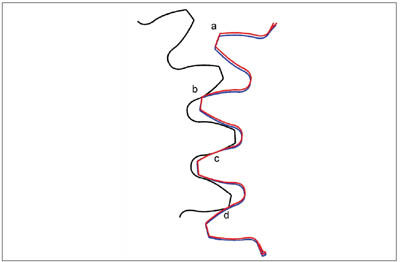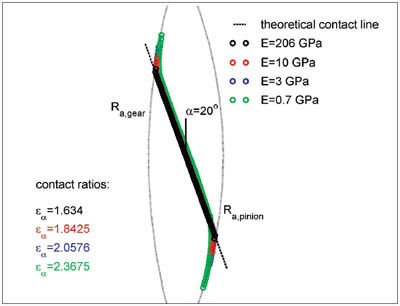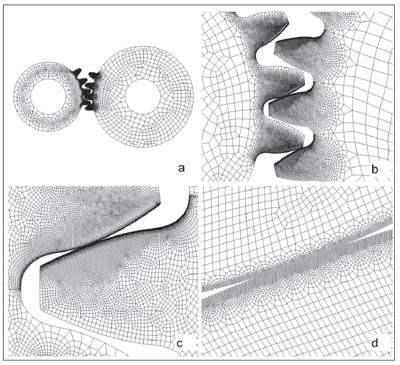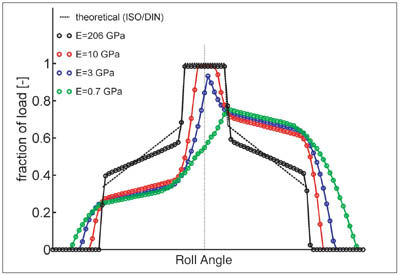This year the Gear University format is identical in
topic to that of 2007, but there are some minor changes to the young, evolving program. Organizers have decided to limit each presentation to one hour, as in the past they were not limited and tended to drag on in some instances. This also allows for the curriculum to cover more subjects. This year there will be more advanced topics such as ISO standards versus AGMA standards, reflecting recent industry trends.
Since the intention of the Gear University is not to sell any products, Wheeler says he “can’t say this expanded the business.” There is, however, a practical benefit he hopes the company will glean. ABA-PGT would like to draw attention to its historical reputation as a pioneer in the plastic gearing industry. ABA-PGT published the first extended book about plastic gear making in 1967 written by William McKinlay and Samuel D. Pierson. This was the first time equations pertaining to plastic gear design were put into book form available to anyone, according to Wheeler. ABA-PGT says on its website that, “Rather than patent our discovery work in plastics gearing, we opted to share our knowledge.”
Plastics Gearing, otherwise known as the “Orange Book,” has been recently updated with a new chapter and is available by request for full download on the ABA-PGT website (www.abapgt.com).
Overall, feedback from the Gear University has been very positive, which is reflected by an evaluation form for the event that was completed by several attendees. The respondents spoke highly of the experience, especially regarding the Rensselaer facility. Six out of the eight presenters came from ABA-PGT; the other two were outside consultants that agreed to participate. Frank Ruck, director of business development at ABA-PGT will be presenting at this year’s event for the second time on the subject of mold construction. From the presenter’s angle, “I thought it was well received by participants; they asked a number of questions,” Ruck recalls.
Ruck stresses the informational and educational aspect of the event, and the necessity of educating people about gear design. He believes there is a perception about gears as being mystical or representing some sort of black magic, because information on the subject is not always out in the open, or as Wheeler mentioned, that gear design is learned mostly from experience and not through education. Despite this mysterious nature, Ruck says there is a great deal of educational material on the subject, and he points to the benefits of disseminating information about plastic gear design. “The more we can enlighten people about gears, the better off everyone will be,” he says.
“The Art of Gear Manufacturing”
Collaboration, creativity, stimulate, vision, detail. No, we aren’t straying from the subject of plastic gear manufacturing. These buzzwords are the essence and focus that define Winzeler Gear, according to Winzeler. With a truly unique and individual approach to the plastic gear industry, Winzeler Gear uses art and partnership as “a vision for who we are and what we represent,” Winzeler says.
Located just outside Chicago, every corner of the plant has been strategically designed and considered in how it relates to the entire facility. From the painted walls adorned with colorful murals to the bright orange and purple pipes, automation cells and each custom painted machine and lift truck, art operates at every level of Winzeler Gear, and every last detail is meticulously planned. The plant today is the result of a 20-year transformation that began one holiday season with new floors, mainly in response to a need for cosmetic rebuilding, which turned into a full-blown business revamping with emphasis on attention to detail and full automation.
Winzeler credits his father and grandfather as major influences, in addition to his background in engineering and his early career as a professional power boat racer. The family business witnessed a gradual transformation in its early years as well. First started as a tool and die making business in 1908 that was driven out of business as a result of the Depression, Winzeler Manufacturing was established in 1940 producing stamped metal gears for the radio, appliance and toy industries. Harold Winzeler foresaw the future in plastic materials, and thus the focus of Winzeler Gear today was established. The two elder Winzelers seemed to enjoy running their business, which they conveyed to the younger Winzeler. With a college degree in engineering as another major influence, John Winzeler carried the designing gene; he enjoyed taking things apart and trying to put them back together. “As an engineer by training, the desire to create stuff comes out of it,” he explains.

Custom-designed boxes transported by a custom-painted lift truck.
In his mid-30s, Winzeler made an important decision to give up his career racing and designing boats, which he loved, to throw himself into the family business. At the time, he wondered how he could apply his hunger for creativity to a new profession. He recalls telling himself, “If I’m going to make my work my life, how was it going to be fun?”
Art may be the most apparent sign of innovation at Winzeler Gear, but there are other unique initiatives the company employs. Partnership is a method Winzeler engages to create mutual opportunities. This approach came about a decade ago in an effort to further develop the business and benefit from cooperative ventures. “As a small company without huge buying power, we tried to come up with a way to leverage suppliers to do joint marketing, business development,”
he says.
Winzeler Gear’s strategic partners include Engel, DuPont, RJG, Inc. and Bradley University. All of the molding machines at Winzeler come from Engel, while Dupont supplies materials and Bradley performs research for the gear manufacturer. The Winzeler plant essentially serves as a showroom for Engel, and the partnerships function at many levels for all the businesses involved. Research and Development is the latest enterprise Winzeler is investing in. He views R&D as a critical element for business development with plastics.
The complete factory automation was another component of the plant rebuilding effort. Winzeler noted that in order to attract large-volume business, he needed to increase production in means that are not possible purely with labor. Particularly in the United States, where labor regulations and union considerations are critical factors, Winzeler knew that he could not create large quantities solely using a human workforce. Before the factory was automated as it is today, a decade ago, 50 employees were required to produce 2 million gears in a month. In the same time span, Winzeler Gear is now capable of manufacturing 12 million plastic gears with only 35 employees.

The Atrium, gallery and gear molding area at Winzeler Gear.
Attention to detail is another component of Winzeler’s unique business model. The actions, appearance and behavior of the employees positively embody the strategies of Winzeler Gear. One client once criticized the company for its small size, but this same critic noted the depth of the employees and their practices, demonstrating strength of knowledge. “John was creating a picture, and the employees had to be part of that picture,” says Warren Edmondson, process engineer.
Edmondson believes they increase progress at Winzeler Gear by working on projects that are more outside of the loop, with business practices to match. Edmondson recalls the dues he paid working at traditional factories and the differences in his life working at Winzeler Gear. “I work in a place that is much more than a factory,” he says.
Although Winzeler acknowledges many personal in-fluences to the form his company takes today, he refuses to take credit. He cites the collaborative work of a highly innovative creative team synergy. They do not just manufacture gears at Winzeler Gear. The majority of its business is in gear product design. Engineers conceptualize entire products for clients, although they only produce the gears—so far. The creative aspect of the business provides benefits in how the company is perceived in the marketplace, and Winzeler says that foreign visitors in particular relate very well to his business model. With the positive, engaging feedback foreign clients offer, Winzeler is targeting global customers more. They already make up about 20 percent of his buyers. Winzeler mentions the “WOMP,” factor, or “word of mouth potential,” which he hopes is a dynamic at work with his company. “People may love or hate the idea, but they never forget it.”
Innovation Crafted from Limitation
“While the plastics industry is growing substantially worldwide, it is struggling to maintain modest growth in North America,” according to the 2007 North American Plastics Industry Study on the plastic processing industry.
Today’s American manufacturers face a truly difficult challenge when it comes to distinguishing themselves and remaining competitive amidst the flood of international gear production. In the plastic gear manufacturing sphere, several domestic companies demonstrate unique and innovative business practices, which would be lost if the respective businesses were separated from their manufacturing facilities by vast distance and complex language barriers. This doesn’t even consider the dramatic social, cultural and economic differences that exist internally, but more importantly, that exist between countries.
“Highly successful companies appear smaller. The technical niche they exploit may be better suited to a narrower market,” the plastic processing industry study suggests.
Plastic is a distinct material in the gear industry, and the American companies that deal with it have a distinct opportunity they can take advantage of. Smaller domestic companies may benefit from testing unconventional ideas and eccentric, alternative methods towards their businesses. Some healthy risk-taking shouldn’t act as a deterrent. All innovation takes is a little coloring outside the lines, or as Felsenthal says, “We dance to the tune of a different drummer.”
For more information:
ABA-PGT Inc.
P.0. Box 8270
Manchester, CT 06042-0270
Phone: (860) 649-4591
Fax: (860) 643-7619
www.abapgt.com
Kleiss Gears, Inc.
390 Industrial Avenue
Grantsburg, WI 54840
Phone: (715) 463-5995
Fax: (715) 463-5996
www.kleissgears.com
Winzeler Gear
7355 W. Wilson Ave.
Harwood Heights, IL 60706
Phone: (708) 867-7971
Fax: (708) 867-7974
www.winzelergear.com









